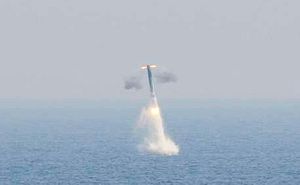BrahMos Aerospace, a joint venture between India’s Defense Research Development Organization and Russian rocket design bureau NPO Mashinostroyeniya, is working on a next-generation supersonic cruise missile, designated BrahMos-NG, for the Indian Navy’s new fleet of Project-75 India (Project-75 I) diesel-electric attack submarines (SSK).
A first test firing of the lighter and sleeker BrahMos-NG is expected to take place within the next two years. The new weapon system is expected to be operationally deployed by 2024. The submarine-launched variant of the BrahMos-NG is likely to take a while longer to develop and no firm date has been set.
According to the website defenseworld.net, the BrahMos NG will feature a digital fuel injection system enabling increases of the missile’s speed from Mach 2.8 to Mach 3.5. The missile will still have the same official operational range of about 290 kilometers. It will weigh about 50 percent less than the original BrahMos and will also be three meters shorter than its predecessor.
The original BrahMos, named after the Brahmaputra River in India and the Moskva River in Russia, is an upgraded variant of the Russian-made P-800 Oniks over-the-horizon supersonic anti-ship cruise missile. No specifics have so far been revealed about the submarine-launched variant of the BrahMos NG save that it can be launched from a sub’s torpedo tubes and will also have a land-attack/anti-ship capability.
The original BrahMos sub-launched variant was first test fired from a submerged platform in 2013. Unlike the BrahMos NG, its bigger predecessor can only be fired vertically from a modular launcher. To date, there are no plans to integrate the original BrahMos missile with India’s attack submarine fleet.
Under Project-75 I, Russia has been pitching India a new SSK class based on the Russian Amur-1650 boat, the export version of the Project 677 Lada class, emphasizing that it would be capable of firing the BrahMos NG supersonic cruise missile.
“The joint SSK project would reportedly involve a significant transfer of military technology from Russia to India that would go beyond usual license-production agreements,” I explained last week.
The Indian Ministry of Defense’s (MoD’s) Defense Acquisition Council, the ministry’s principal procurement body, approved the procurement of the six new SSKs in January 2019 under the MoD’s strategic partnership (SP) model within the framework of the Defense Procurement Procedure 2016.
Russia will be competing with Naval Group (France), Kockums (Sweden), and Howaldtswerke-Deutsche Werft (Germany) for the contract.
The Indian government is not expected to make a selection of an international sub maker, referred to as the original equipment manufacturer (OEM), for two to three years.
“The OEMs would be shortlisted primarily based on their submarine design meeting the Indian Navy’s Qualitative Requirements and qualifying the Transfer of Technology and Indigenous Content (IC) criteria,” the MoD said in a June 2019 statement.
Importantly, the new subs are expected to be fitted with an air-independent propulsion (AIP) system, something that the Russian shipbuilding industry has been struggling to build for years.

































